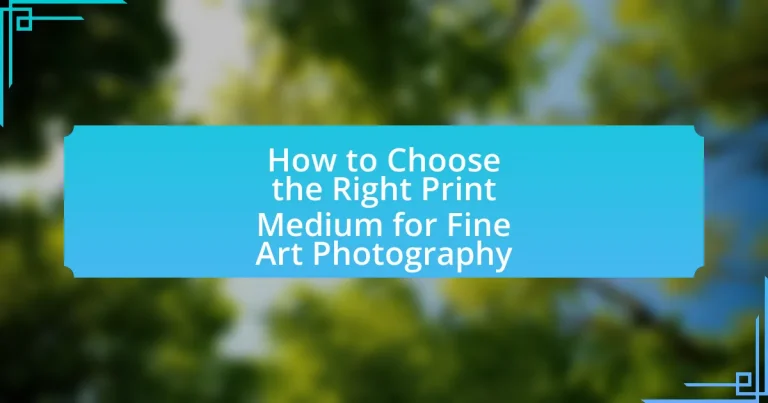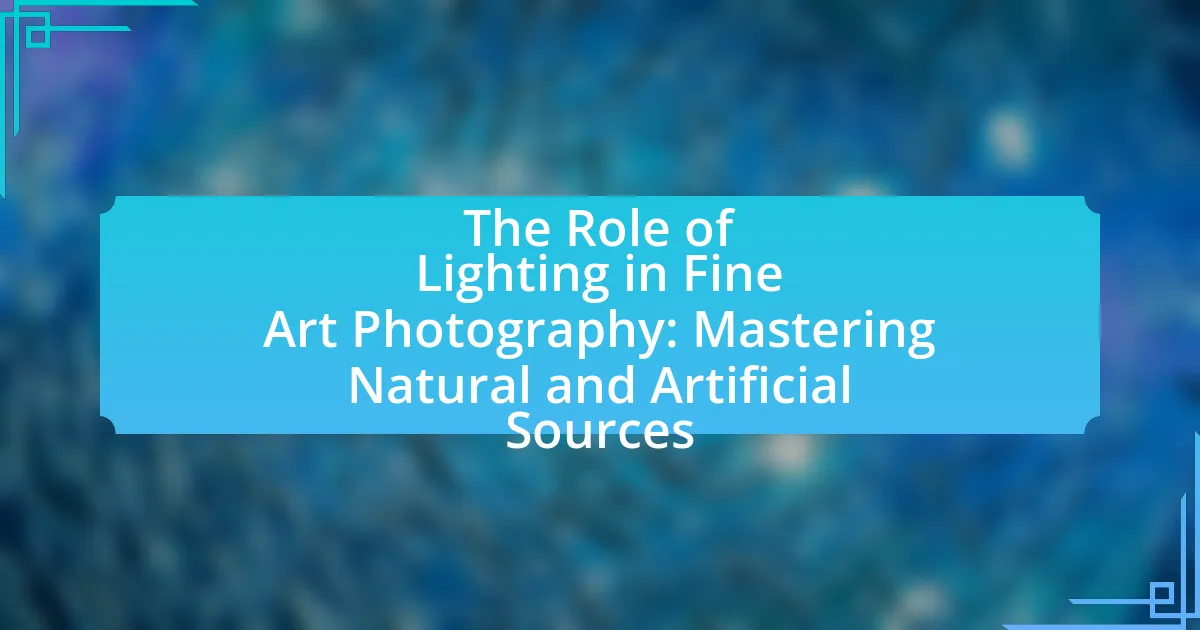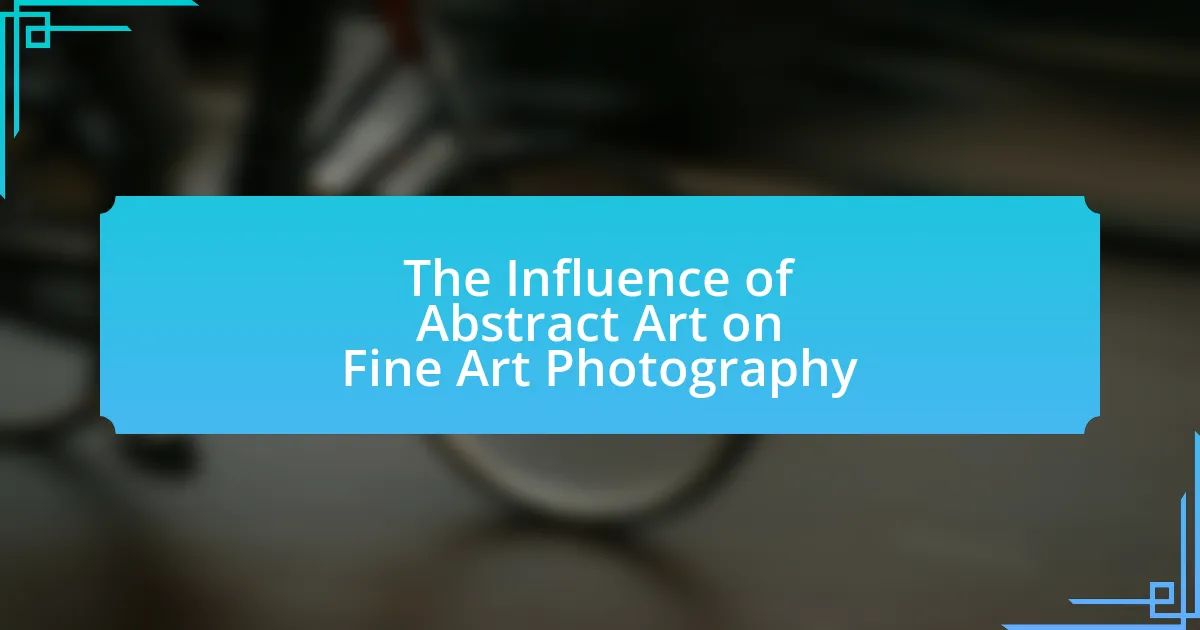Choosing the right print medium for fine art photography is essential as it affects the visual impact, longevity, and presentation of the artwork. The article explores various print mediums, including canvas, fine art paper, and metal, detailing their unique characteristics and how they influence color reproduction, texture, and viewer perception. It emphasizes the importance of considering the intended use of the print, the subject matter, and the emotional response elicited by different mediums. Additionally, the article provides guidance on evaluating and selecting the appropriate print medium, highlighting common mistakes to avoid and best practices for achieving optimal results in fine art photography.
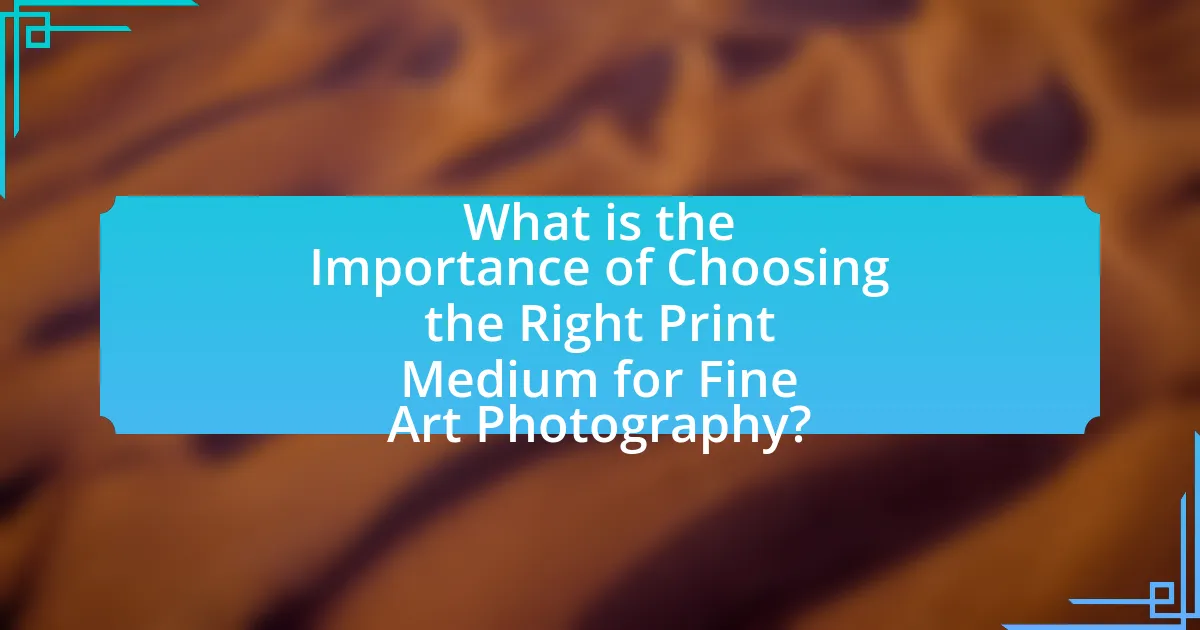
What is the Importance of Choosing the Right Print Medium for Fine Art Photography?
Choosing the right print medium for fine art photography is crucial because it directly influences the visual impact, longevity, and overall presentation of the artwork. Different print mediums, such as canvas, fine art paper, or metal, each offer unique textures, color renditions, and durability, which can enhance or detract from the photographer’s intended expression. For instance, archival-quality papers can preserve images for decades without fading, while canvas can provide a three-dimensional effect that adds depth. The choice of medium also affects how the artwork interacts with light, which can alter the viewer’s perception. Therefore, selecting an appropriate print medium is essential for achieving the desired aesthetic and ensuring the artwork’s longevity.
How does the print medium affect the overall presentation of fine art photography?
The print medium significantly influences the overall presentation of fine art photography by affecting color reproduction, texture, and viewer perception. Different print mediums, such as glossy paper, matte paper, or canvas, can enhance or diminish the visual impact of an image. For instance, glossy prints often produce more vibrant colors and sharper details, making them suitable for images that require high contrast, while matte prints can offer a softer, more subdued appearance that may be preferred for portraits or landscapes. Additionally, the choice of medium can evoke different emotional responses; for example, a textured canvas print may convey a sense of depth and authenticity, enhancing the artwork’s connection with the viewer. Research indicates that the physical characteristics of the print medium can alter viewer engagement and interpretation, underscoring the importance of selecting the appropriate medium to align with the artistic intent.
What are the visual characteristics of different print mediums?
Different print mediums exhibit distinct visual characteristics that influence the presentation of fine art photography. For instance, glossy paper enhances color vibrancy and contrast, making images appear more dynamic, while matte paper offers a softer, more subdued look that reduces glare and enhances texture. Canvas prints provide a three-dimensional quality, adding depth and a tactile feel, which can evoke a sense of warmth and authenticity. Metal prints, on the other hand, deliver high saturation and sharpness, creating a modern aesthetic with a sleek finish. Each medium’s unique properties affect how colors, details, and textures are perceived, thus impacting the overall visual experience of the artwork.
How does the choice of medium influence the viewer’s perception?
The choice of medium significantly influences the viewer’s perception by affecting the emotional response and interpretation of the artwork. Different mediums, such as canvas, paper, or metal, can evoke distinct feelings; for instance, a glossy metal print may convey modernity and vibrancy, while a textured canvas can suggest warmth and tradition. Research indicates that the physical properties of a medium, including texture and color saturation, directly impact how viewers engage with the artwork, as demonstrated in studies on visual perception and emotional response. This relationship between medium and perception underscores the importance of selecting the appropriate print medium in fine art photography to enhance the intended message and emotional impact of the piece.
Why is it essential to consider the intended use of the print?
Considering the intended use of the print is essential because it directly influences the choice of print medium, which affects the artwork’s presentation and longevity. For instance, prints intended for gallery display may require archival-quality materials to ensure durability and visual impact, while prints for personal use may prioritize cost-effectiveness. Research indicates that the right medium can enhance color accuracy and texture, which are critical for fine art photography, thereby ensuring that the artist’s vision is effectively communicated to the audience.
What factors should be considered for gallery exhibitions?
Key factors to consider for gallery exhibitions include the selection of artwork, the layout and design of the exhibition space, lighting, audience engagement, and marketing strategies. The selection of artwork should align with the theme and purpose of the exhibition, ensuring that it resonates with the target audience. The layout and design must facilitate a smooth flow for visitors, allowing them to appreciate each piece without obstruction. Proper lighting enhances the visual impact of the artwork, highlighting details and colors effectively. Audience engagement strategies, such as interactive elements or guided tours, can enhance visitor experience and understanding. Finally, effective marketing strategies are essential to attract visitors and promote the exhibition, utilizing social media, press releases, and partnerships with local organizations. These factors collectively contribute to the success of a gallery exhibition.
How does the choice of medium vary for personal collections versus commercial sales?
The choice of medium for personal collections typically emphasizes individual preference and emotional connection, while commercial sales prioritize market trends and customer appeal. Personal collectors often select mediums that resonate with their personal taste, such as unique prints or handcrafted items, which may include limited editions or alternative processes like cyanotypes. In contrast, commercial sales often focus on widely accepted mediums like glossy or matte photographic prints, which are more likely to attract a broader audience and meet consumer demand. This distinction is supported by market research indicating that personal collectors value uniqueness and artistic expression, whereas commercial buyers often seek familiarity and mass appeal in their purchases.
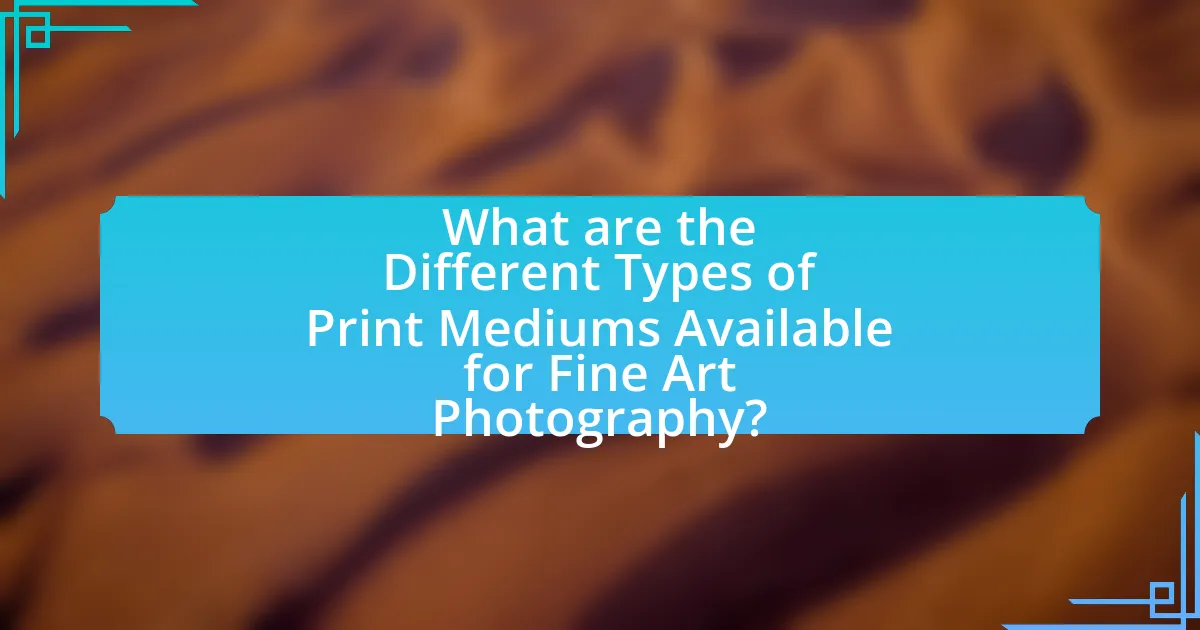
What are the Different Types of Print Mediums Available for Fine Art Photography?
The different types of print mediums available for fine art photography include traditional photographic paper, canvas, metal, acrylic, and wood. Traditional photographic paper, such as glossy or matte finishes, is commonly used for its high-quality reproduction of colors and details. Canvas prints offer a textured surface that enhances the visual depth of images, making them suitable for large-scale artworks. Metal prints provide a modern aesthetic with vibrant colors and durability, while acrylic prints create a sleek, contemporary look with a glossy finish that enhances image clarity. Wood prints offer a unique, organic feel, adding warmth and character to the artwork. Each medium has distinct characteristics that can influence the presentation and perception of fine art photography.
What are the characteristics of traditional print mediums?
Traditional print mediums are characterized by their physical form, texture, and the quality of the printed image. These mediums include materials such as paper, canvas, and metal, each offering distinct visual and tactile experiences. For instance, paper can vary in weight, texture, and finish, affecting the final appearance of the artwork; glossy paper enhances color vibrancy, while matte paper provides a softer look. Canvas, often used for fine art reproductions, adds depth and a three-dimensional quality to images, while metal prints offer durability and a modern aesthetic with vibrant colors and sharp details. The choice of traditional print medium significantly influences the presentation and perception of fine art photography, making it essential for artists to consider these characteristics when selecting the appropriate medium for their work.
How do silver gelatin prints differ from inkjet prints?
Silver gelatin prints differ from inkjet prints primarily in their production process and material composition. Silver gelatin prints are created using light-sensitive silver halide crystals suspended in gelatin, which are exposed to light and then developed in a chemical process, resulting in a continuous tone image with a rich depth and texture. In contrast, inkjet prints utilize digital technology to apply liquid ink onto paper, allowing for a wider color gamut and the ability to reproduce images quickly and easily. The archival quality of silver gelatin prints is often superior due to their chemical stability, while inkjet prints can vary significantly based on the type of ink and paper used, affecting longevity.
What are the advantages of using darkroom techniques?
The advantages of using darkroom techniques include greater control over the photographic process, the ability to produce unique prints, and the opportunity for hands-on creativity. Darkroom techniques allow photographers to manipulate exposure, contrast, and tonal range, resulting in prints that reflect their artistic vision. Additionally, the darkroom process can yield one-of-a-kind images, as each print can be individually crafted, enhancing the uniqueness of fine art photography. Historical context shows that many renowned photographers, such as Ansel Adams, utilized darkroom techniques to achieve specific aesthetic outcomes, demonstrating the method’s effectiveness in producing high-quality, expressive images.
What modern print mediums are popular among fine art photographers?
Modern print mediums popular among fine art photographers include archival inkjet prints, metal prints, and canvas prints. Archival inkjet prints utilize high-quality inks and papers designed to last over time, ensuring color accuracy and longevity. Metal prints offer a contemporary aesthetic with vibrant colors and a sleek finish, achieved through dye-sublimation on aluminum. Canvas prints provide a textured, artistic look, often used for reproducing paintings or photographs with a painterly effect. These mediums are favored for their durability, visual appeal, and ability to enhance the artistic expression of fine art photography.
How do giclée prints compare to other digital printing methods?
Giclée prints are superior to other digital printing methods in terms of color accuracy, longevity, and detail. Giclée printing utilizes high-quality inkjet technology that employs archival inks and fine art paper, resulting in prints that can last over 100 years without fading, compared to standard digital prints which may degrade significantly faster. Additionally, giclée prints can reproduce a wider color gamut, allowing for more vibrant and precise color representation, which is essential for fine art photography. This method is often preferred by artists and photographers for its ability to capture intricate details and subtle tonal variations, making it a preferred choice in the fine art community.
What role does paper type play in the quality of the print?
Paper type significantly influences the quality of the print by affecting color reproduction, texture, and durability. Different paper types, such as glossy, matte, or fine art paper, interact uniquely with inks, impacting how colors appear and how details are rendered. For instance, glossy paper enhances vibrancy and sharpness, making colors pop, while matte paper offers a softer, more subdued finish that can enhance texture and depth. Additionally, fine art papers, often made from cotton or alpha-cellulose, provide archival quality, ensuring longevity and resistance to fading. Studies have shown that prints on high-quality paper can last over 100 years without significant deterioration, underscoring the importance of selecting the appropriate paper type for achieving optimal print quality in fine art photography.
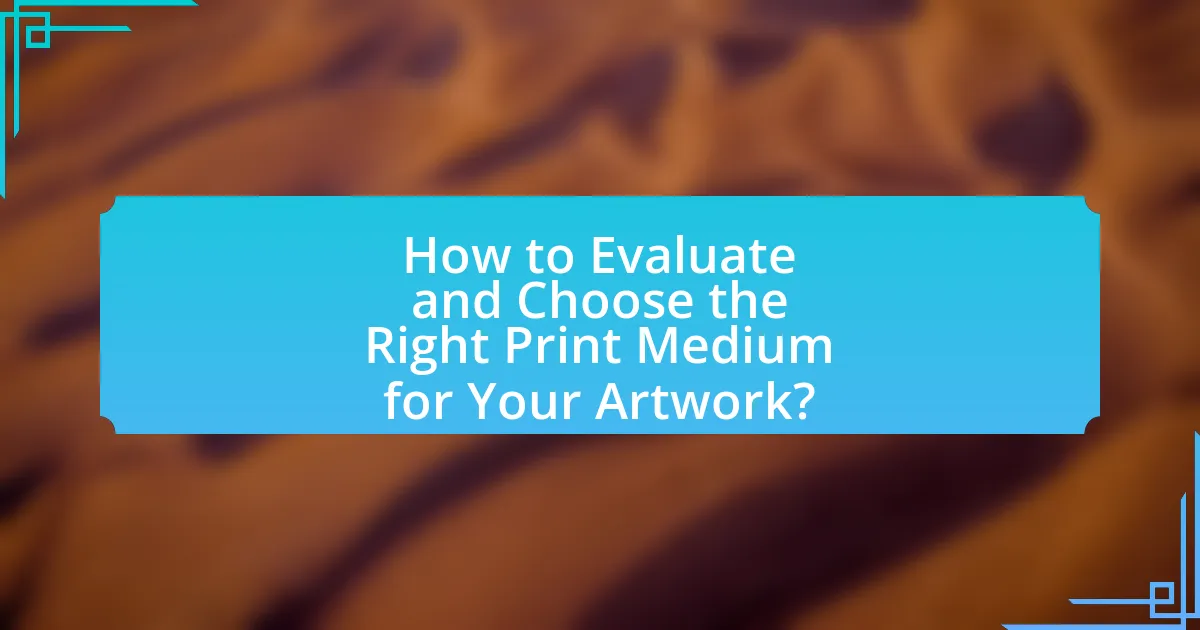
How to Evaluate and Choose the Right Print Medium for Your Artwork?
To evaluate and choose the right print medium for your artwork, first assess the characteristics of your artwork, including color, texture, and intended emotional impact. Different print mediums, such as canvas, fine art paper, or metal, can significantly alter the presentation and perception of the artwork. For instance, canvas prints offer a textured surface that enhances depth, while fine art paper provides a smooth finish that captures intricate details and color accuracy.
Additionally, consider the longevity and archival quality of the print medium. Research indicates that certain papers, like acid-free or cotton rag, can last over 100 years without fading, making them suitable for fine art photography. The choice of medium should also align with the intended display environment; for example, metal prints are more durable and suitable for outdoor settings.
Ultimately, the right print medium should complement the artwork’s style and purpose, ensuring that it resonates with viewers while maintaining its integrity over time.
What criteria should you consider when selecting a print medium?
When selecting a print medium for fine art photography, consider factors such as the type of paper, texture, weight, and finish. The type of paper affects color reproduction and longevity; for instance, archival-quality papers enhance durability and prevent fading. Texture influences the visual impact; smooth papers provide sharp details, while textured papers add depth. Weight is crucial for handling and framing; heavier papers are often more durable and convey a sense of quality. Finally, the finish—glossy, matte, or satin—affects the image’s appearance and viewer perception, with glossy finishes enhancing vibrancy and matte finishes reducing glare. These criteria ensure that the chosen medium complements the artistic intent and enhances the overall presentation of the work.
How does the subject matter influence the choice of print medium?
The subject matter significantly influences the choice of print medium by determining the visual and emotional impact of the artwork. For instance, vibrant colors in a landscape photograph may be best represented on glossy paper, which enhances saturation and detail, while a black-and-white portrait might benefit from a matte finish that softens contrasts and adds depth. Research indicates that different print mediums can alter the perception of an image; for example, a study published in the Journal of Imaging Science and Technology found that the choice of paper can affect viewers’ emotional responses to photographs. Thus, the characteristics of the subject matter guide artists in selecting the most appropriate medium to convey their intended message effectively.
What is the significance of color accuracy and longevity in print selection?
Color accuracy and longevity are crucial in print selection for fine art photography because they ensure that the artwork is represented faithfully and retains its quality over time. Accurate color reproduction allows viewers to experience the artist’s intended vision, while longevity ensures that prints do not fade or deteriorate, preserving the artwork’s integrity for future generations. Research indicates that archival inks and high-quality paper can significantly enhance both color fidelity and lifespan, with some prints lasting over 100 years without noticeable degradation. This combination of factors is essential for artists and collectors who value both aesthetic quality and investment in their works.
How can you test different print mediums before making a final decision?
To test different print mediums before making a final decision, you should create sample prints using various mediums such as canvas, fine art paper, and metal. This allows you to evaluate the color accuracy, texture, and overall aesthetic of each medium in relation to your artwork. By comparing these samples side by side, you can assess how each medium enhances or detracts from the visual impact of your photography. Additionally, consider factors like durability and how well each medium holds up under different lighting conditions, as these aspects can significantly influence your final choice.
What are the best practices for conducting print tests?
The best practices for conducting print tests include selecting a variety of print mediums, ensuring consistent lighting conditions, and using high-quality source images. By testing multiple mediums, such as glossy, matte, and fine art papers, photographers can evaluate how different surfaces affect color reproduction and detail. Consistent lighting is crucial, as it allows for accurate assessment of print quality without external influences altering perception. Additionally, using high-resolution images ensures that the tests reflect the true capabilities of the print medium. These practices are supported by industry standards, which emphasize the importance of controlled environments and quality materials in achieving optimal print results.
How can feedback from peers influence your choice of medium?
Feedback from peers can significantly influence your choice of medium by providing diverse perspectives on the effectiveness and emotional impact of different print options. When peers share their opinions on various mediums, such as matte versus glossy finishes or different types of paper, they can highlight aspects you may not have considered, such as texture, color fidelity, and viewer engagement. Research indicates that peer feedback can enhance decision-making processes, as it allows artists to refine their choices based on collective insights and experiences, ultimately leading to a more informed selection that resonates with the intended audience.
What are some common mistakes to avoid when choosing a print medium?
Common mistakes to avoid when choosing a print medium include not considering the intended use of the print, overlooking the compatibility of the medium with the artwork, and failing to evaluate the longevity and durability of the print. For instance, selecting a glossy paper for a piece with heavy texture may not showcase the artwork effectively, while using a medium that fades quickly can diminish the value of fine art photography. Additionally, neglecting to test print samples can lead to unexpected results, as colors may appear differently on various mediums.
How can overlooking the print medium affect the final artwork?
Overlooking the print medium can significantly compromise the quality and impact of the final artwork. The choice of print medium influences color accuracy, texture, and longevity, which are critical for conveying the artist’s vision. For instance, using a low-quality paper can result in dull colors and poor detail reproduction, while archival-quality papers enhance vibrancy and preserve the artwork over time. Research indicates that prints made on high-quality mediums can last over 100 years without fading, while those on inferior materials may deteriorate within a decade. Therefore, neglecting the print medium can lead to a diminished aesthetic experience and a shorter lifespan for the artwork.
What are the pitfalls of choosing a medium based solely on cost?
Choosing a medium based solely on cost can lead to significant pitfalls, including compromised quality and durability. When cost is prioritized, artists may select lower-quality materials that do not accurately represent their work, resulting in poor color reproduction and detail loss. For instance, using inexpensive paper can lead to fading and deterioration over time, undermining the longevity of the artwork. Additionally, cost-driven choices may limit the range of mediums available, preventing artists from exploring options that could enhance their creative expression. Ultimately, prioritizing cost over quality can diminish the overall impact and value of fine art photography.
What tips can help you successfully choose the right print medium for your fine art photography?
To successfully choose the right print medium for fine art photography, consider the characteristics of the image and the intended display environment. Different mediums, such as glossy paper, matte paper, canvas, or metal, can significantly affect the visual impact and longevity of the artwork. For instance, glossy paper enhances color vibrancy and detail, making it suitable for images with rich colors, while matte paper reduces glare and is ideal for softer images or those with subtle tones. Additionally, canvas prints offer a textured finish that can add depth to the artwork, making them popular for large-scale displays. Research indicates that the choice of medium can influence viewer perception and emotional response, emphasizing the importance of aligning the medium with the artistic vision and context of the work.












